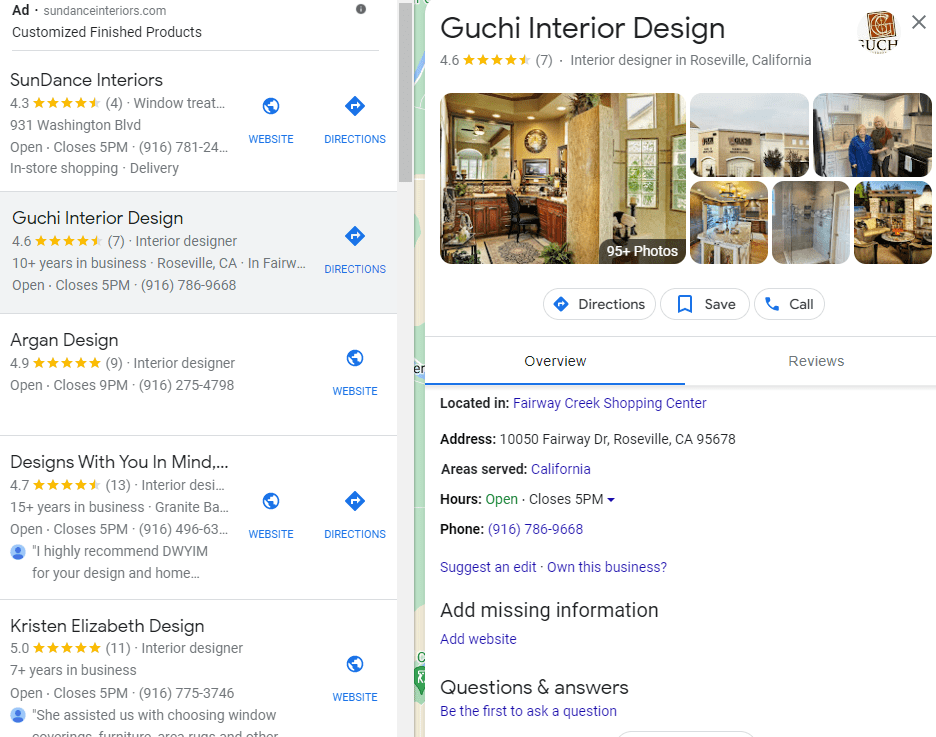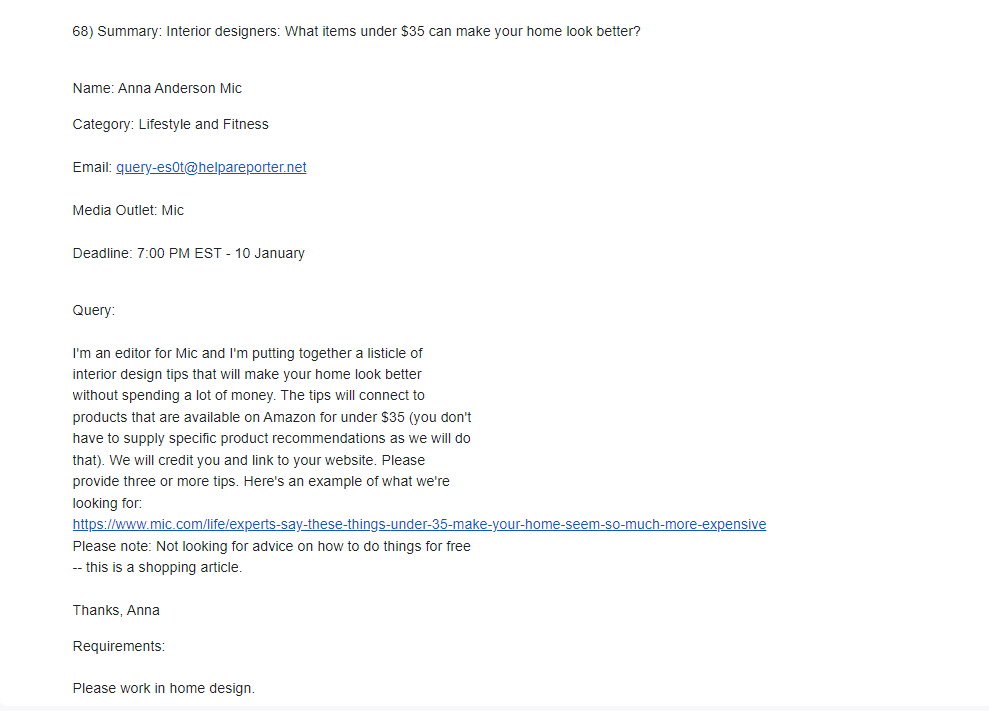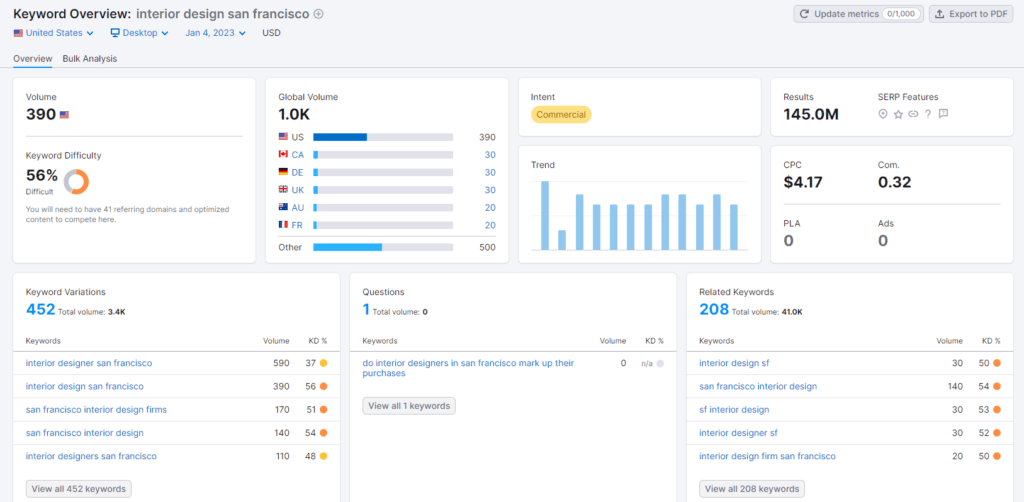When people look for an interior designer, they almost always start with a Google search. You want them to find and pick you, not your competitors.
To do that, you need search engine optimization. You need your website to have the right structure and content – especially the right keywords – to make sure it comes up for Google searches like “interior designers near me.”
We’ve put together a full rundown, specifically for interior designers, of all the basics you need to do to create and execute an SEO strategy that brings in a steady flow of new customers and sales.
Here’s how to kickstart your SEO campaign.
Optimize Your Google Business Profile
Google Business Profile (formerly known as Google My Business) is an absolute must for local businesses. It’s a critical part of SEO these days. If you haven’t set yours up yet, it’s one of the very first things you should do as part of your SEO strategy.
GBP listings are a huge part of how Google decides what shows up for local and “near me” searches, as well as which businesses they feature in the “map pack” at the top of the search engine results page.
Here’s a rundown of how to set up a GBP page for your interior design business. You can also check out Search Engine Journal’s excellent GMB guide here.
When you set up a new GMB page for a business, the verification is done via a postcard Google will send you via snail mail. It usually takes around 3-5 business days.
6 Tips for Setting Up Your GBP Page
Here are a few tips for making the most of a GBP profile for your business:
- Enter as much data as you can. Fill out any fields if you have the information for them. The more info, the better.
- Include relevant keywords. We’ll get to keyword research a bit later in the article. Once you know what keywords you’re targeting, though, try to include them anywhere you can (as long as it sounds natural).
- Ensure your business name, address, phone number, and office hours are accurate.
- Name, address, and phone number are, together, referred to as “NAP data.” This is key for GBP and loca SEO in general. You want to make sure it’s consistent across any sites, directories, and platforms where your business is listed – GMB, especially.
- Post periodically to GBP . Like social media, you can make posts directly on GBP . It’s a good idea to create a schedule for that, create copy, and post regularly to keep things active and updated. Interior design is a very visual industry – include high-quality images, as well as video if you have it.
- Once you’re set-up, you can use “GBP Profile Insights” to find out how customers are interacting with your GBP page. You can get data on things like how people are finding your GBP page, how many phone calls you’re getting via GBP , and more.

Submit Your Site to Online Directories
Directories and professional organizations’ websites are great ways to get some easy but good quality links to your website, and get in front of more customers. High-quality backlinks are an important ranking factor for Google.
One place you can start with this is to register with your city’s local Chamber of Commerce. Most municipalities have an online directory for Chamber of Commerce members.
While directories per se aren’t as widespread as they were a decade ago – as search engines improved, they became less vital as a part of how most people navigate the web – there are still quality local directories out there in most cities.
A go-to example of a modern directory is Angie’s List. It’s a great place to list your interior design business.
Along with listing your company in relevant directories, it’s also a good idea to maintain memberships in professional organizations. The “big four” for Interior design are the American Society of Interior Designers; the American Institute of Architecture; the International Interior Design Association; and the International Furnishing and Design Association.’
Encourage Your Clients to Leave Google Reviews
Online reviews are a big part of local SEO. When people look for a service online, one of the first things they do is see who has the best reviews.
You want a high number of reviews, but even more importantly, a good total average score.
For local and “near me” searches, Google considers three main factors:
- Relevance
- Distance
- Prominence
Reviews are a huge part of how Google’s algorithms calculate “Prominence.” The more positive reviews you have, the better your chances of getting onto the first page when people in your area search for “interior designers near me.”
Along with your website and your GMB page, many industry platforms and directories also have functionalities for user reviews. Some big ones include Angie’s List, TrustPilot, Houzz, and Clutch.
How do you get customers to leave a review?
Of course, to take full advantage of the value of positive reviews, you need to get your customers to take the time to create them.
A lot of the time, you can simply ask clients outright. If someone makes a positive comment to you about your service, feel free to ask if they’d be willing to let you quote that as a testimonial for your site, and to leave a review on GMB or another platform.
Some businesses do offer incentives in exchange for reviews, like discounts or gift cards. However, we’d recommend being very cautious with this kind of strategy. Google’s best practices recommendations actively discourage this kind of thing.
Signup for Haro
“Help a Reporter Out” – better known as HARO – is a service that helps connect journalists with sources, especially businesses. This has a lot of value for SEO.
If a journalist quotes you, they’ll almost always include a link in the text to your site. This is what we call an “editorial link,” and it’s the best kind of link you can get. It’s legitimate, earned, and natural, and Google puts a lot of value on these.
Some of the ways you can help out a journalist are to let them quote you as a subject matter expert or provide them with something newsworthy your company did that they can write an article about.
Along with its SEO value, getting mentioned by a journalist is also great for general PR.
HARO has a couple of different tiers you can sign up for. Their basic package is entirely free, but they also have paid plans that offer additional features. These range from $19 to $149 per month.
One benefit of getting a paid plan is that you’ll be able to filter messages based on specific keywords that are relevant to interior design. The most basic paid plan lets you choose one keyword, the medium tier allows three, and the premium tier lets you choose an unlimited number of keywords.
This, of course, prevents your inbox from being swamped with irrelevant HARO queries.
Signing Up for HARO
Here’s how to sign up for HARO:
- Register at helpareporterout.com as a “Source”
- Set your preferences. (You’ll want to use these settings to refine by industry as much as you can.)
- Once you’re signed up, you’ll start regularly getting emails with recent reporter queries.
It’s that simple!
Responding to Queries
Once you’re set up and getting query emails, the next step is responding if you get one that seems promising. To respond, you can either email the journalist directly at their professional email address or simply respond directly to the HARO message.
Keep an eye on the journalist’s deadline, and make sure you reach out in a timely manner.
It’s also a good idea to keep your responses as concise as you can, while still including all the relevant info you need. Do include a little info on yourself and your background, as well as your contact info and a link to your site.
You can use the “My Pitches” tab on HARO’s site to see if your answers were accepted.

Along with making sure all your location info is correct on GMB, you’ll also want to optimize your website itself for the primary location that you serve. Include the city or region name in key places like the body text on your web pages, and in the page titles.
It’s also a good idea to have a footer section on each page that has your address & phone number in it.
Create Location Pages For Different Areas That You Serve
A lot of companies aren’t limited to just one town or city. If that’s the case for you, you’re going to want what are called “location pages.”
Basically, they’re a separate landing page for each main area where you work. (For example, a set of neighboring cities or counties.) These pages tend to account for a very large percentage of the incoming search traffic for local businesses.
Creating Location Pages
One of the most important things here is that each page has to have its own customized page copy. Don’t just copy and paste the same text and then swap out the location names.
Each page should be optimized well for your target keywords, with compelling sales copy and a strong call to action (CTA) encouraging readers to reach out to you about your services.
Along with location pages, you can also have more than one GMB page – but only if you have more than one physical office location in different cities. If you don’t though, doing so is heavily discouraged.
Adding Structured Data Markup
This part is a little on the technical side of SEO. “Structured data” is a standardized format for HTML markup that provides Google with specific data about a page, which signals to Google what kind of content is featured on that page.
This info is used to determine what pages show up in Google’s “Rich Results” – things like info boxes and other features that show up directly on the SERP page.

Link to Your Social Media Profiles
It’s been debated in the SEO industry for years how much of a direct algorithmic effect social media has, or doesn’t have, on search rankings. That said, though, social media is another key facet of digital marketing as a whole.
You don’t necessarily need to have a big presence on every single social media platform – though it’s a good idea to at least “claim your name” by creating and setting up profiles.
Instead, it usually works best to hone in on which platforms are the most effective for your industry and keep your focus on those. For interior design, the most important tend to be Instagram and Pinterest.
These image-heavy social media sites are a prime place to showcase your work and attract new customers. Facebook, Twitter, and LinkedIn can also be worthwhile.
On your website itself, include links to your social media pages.
Pinterest is a must-have for interior designers
As we mentioned, Pinterest is huge for interior design. It’s an absolute must-have, giving you a great place to showcase your aesthetics.
Pinterest revolves around collections of aesthetically consistent and related images, called “Boards.” People love looking for Pinterest boards to find new interior design inspiration, and this is a prime entry point for your sales funnel.
Along with Pinterest itself, images featured on the platform have a heavy tendency to dominate the search results in Google Image Search.
Here are a few tips for making the most of Pinterest:
- Use a business account. Pinterest allows new users to create either a personal account or a business account. The latter is best.
- Use one of your main keywords in your account name.
- Create a publishing schedule to pin new content and create new boards regularly. As with any social media platform, consistency is key. You can use tools like Hootsuite and Buffer to queue up posts ahead of time so they’ll be posted automatically.
- Implement “rich pins” for images on your website. This feature makes it easy for users to share your work on their boards – automatically including info about your business and your website link.
- Use relevant keywords in the descriptions for your pins.
- Organize and label your boards. Keep your boards clearly labeled, organized, and aesthetically cohesive.
- Use Pinterest’s built-in analytics tools. When you have a Business account on Pinterest, you can easily track your reach and engagement on the platform
List your website on industry platforms like Houzz
For interior designers, a Houzz account is indispensable. Houzz is a sort of a hybrid platform, part social media, and part business directory. It’s designed to both help people find home design inspiration, and to connect customers with local businesses.
Using Houzz to Market Your Interior Design Business
Here’s what you need to know about setting up a Houzz account and using it as part of your digital marketing strategy.
- Create an account, and fill out your profile as completely as you can. You can include things like your professional experience and credentials; the services you offer; the design styles in which you specialize; the locations you serve; and your contact details. There’s also a section for the average cost per project.
- Upload your projects. Use high-quality, high-resolution images, and optimize the image file names with relevant keywords. For each project that you share, fill out all of the info fields.
- Create “Ideabooks.” Ideabooks on Houzz are similar to Pinterest boards. Images in an Ideabook should have an optimized file name and a description that also incorporates your keywords.
- Engage with other Houzz users. As with any social media site, you need to actively engage with people to effectively build a presence on Houzz. Follow other people’s profiles, like and comment on their posts, and answer people’s questions with helpful advice.
- Get your customers to leave reviews on Houzz. Houzz has a feature for customer reviews, and it’s a resource people use routinely to find interior designers.
- If you have experience writing about interiors, you can also pitch Houzz’s editorial team with article ideas. You can also submit properties you designed to be featured in “Houzz tours,” a recurring editorial feature.
Perform keyword research to find out what your audience is searching for
This article is about SEO, so of course, we’ve mentioned keywords a lot. What we haven’t gotten to yet, though, is how you find those keywords in the first place.
The go-to way to do this is to use a dedicated SEO software platform. There are a few of these, all of which are pretty great. Some of the big ones include SEMRush, Ahrefs, and BrightEdge.
At JCT Growth, we use a combination of SEMRush and Ahrefs. Both platforms have more or less the same functionality, but like many SEOs, we’ve found that they have slightly different strengths.
For keyword research specifically, SEMRush is our go-to, and the platform we’d recommend the most for this.
SEMRush is a subscription service and starts at around $100 per month. However, they do offer a one-month free trial for new users. You can use the free trial period to build your keyword list, then cancel the account, if you’re not interested in maintaining a long-term subscription. That said, though, SEMRush provides so much value for the price that it’s worth an ongoing subscription.
For keyword research, you’ll want to navigate in SEMRush to the Keyword Overview tool. You can enter anywhere from one to ten keywords, separated by commas. This is where you can get full details for each keyword – how many people search for it per month, how competitive it is, and other related keywords that may also be worth targeting.
Another way to find keywords is to see what your competitors are optimizing for. To do that, you’ll want to go to Domain Overview, then enter the relevant URL.
Basically, this lets you snoop on their analytics. You can see how much traffic they’re getting; what keywords they’re optimizing for; which of their pages rank the best; and more.
You’ll be able to pull a list of their keywords so that you can also optimize for them. (And ideally, outdo them and rank above them!)
This is all just one small slice of SEMRush’s functionality, of course.
Once you’ve got your keywords, you can simply click a button to export the data to an Excel or Google Sheets spreadsheet.

Create themed portfolios around design aesthetics in which you specialize
Along with showcasing your work on platforms like Houzz and Pinterest, you’ll also want to create a portfolio on your website.
One of the best approaches to this, for interior designers, is to create a set of several portfolios, with each one showcasing different design aesthetics. You can show your work in different design styles, like mid-century modern, farmhouse, and other trendy aesthetics, as well as your work with different types of design. (For example, commercial versus residential work.)
Like with Pinterest and Houzz, make sure your images are large, high resolution, and otherwise high quality and shareable.
Create a blog strategy that aligns with your expertise.
So you’ve got your keywords, it’s time to optimize for them. Some of them will be most relevant to your main website pages: home page, service pages, and location pages.
But, there are a lot more, and many of these are best addressed with informational blog content. You can write (or commission, via agencies or freelancers), and publish blog posts that answer common questions that your target audience is Googling.
You’ll want a well-designed blog strategy that aligns with your particular specializations and expertise. Along with its SEO value, your blog also demonstrates your knowledge and establishes you as a knowledgeable authority in the interior design space. We don’t recommend blogging for just the sake of having a blog.
Feeling a bit overwhelmed on where to start? No worries, we’re here to help you grow your business.

